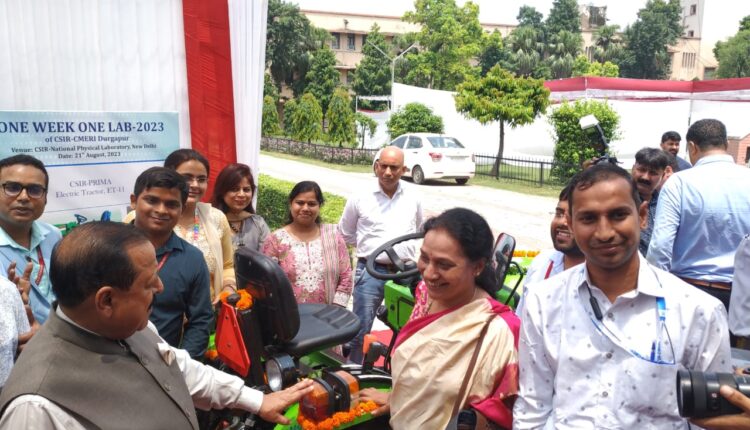CSIR’s E-Tractor: Indian agriculture is undergoing a transformative shift with the introduction of electric-powered farm machinery. The increasing cost of diesel, environmental concerns, and the need for sustainable mechanization have driven the demand for electric alternatives. The Council of Scientific and Industrial Research (CSIR) has developed two groundbreaking innovations—the e-Tiller and the PRIMA ET11 e-Tractor—to address these challenges.
On National Science Day 2025, these machines were flagged off for nationwide trials, marking a new era in sustainable farming solutions. But how do they work, and why should farmers adopt them? Let’s explore their science, technology, and farmer-friendly features in detail.
The Development Team
The development of the e-Tractor (CSIR PRIMA ET11) and e-Power Tiller was spearheaded by a dedicated team at the CSIR-Central Mechanical Engineering Research Institute (CMERI) in Durgapur, West Bengal. This team, operating under the leadership of Prof. (Dr.) Harish Hirani, the Director of CSIR-CMERI, has been instrumental in advancing mechanical engineering technologies tailored to the needs of Indian agriculture.
While specific individual contributors are not detailed in the available sources, the collective expertise of the CSIR-CMERI team encompasses a range of disciplines, including robotics, mechatronics, embedded systems, and precision agriculture. Their collaborative efforts have led to the successful design and development of these electric-powered agricultural machines, aiming to enhance productivity and sustainability for small and marginal farmers in India.
CSIR e-Power Tiller: The Future of Small-Scale Farming
Scientific Innovations Behind the e-Tiller
The CSIR e-Power Tiller is an electric motor-driven tiller designed for small and marginal farmers. Unlike traditional internal combustion engine (ICE) tillers, which rely on petrol or diesel, this machine uses an efficient electric drivetrain.
Key Scientific Advancements:
- Electric Motor Efficiency – The e-Tiller utilizes a high-torque, brushless DC motor (BLDC), which provides instant power delivery with minimal energy loss. This allows for better control and higher efficiency in plowing.
- Low Vibrations & Noise – Conventional petrol tillers cause hand-arm vibration syndrome in operators. The electric system eliminates excessive vibrations, reducing operator fatigue.
- Smart Battery Management System (BMS) – The tiller is equipped with an intelligent lithium-ion battery that optimizes charging cycles and power delivery, ensuring longer operational hours.
- Swappable Battery Technology – Farmers can easily replace battery packs to extend field operation time without long charging breaks.
- Eco-Friendly Operation – The tiller produces zero emissions, making it ideal for organic farming and sustainable agriculture.
Farmer-Friendly Features
- Lower Operating Costs – Compared to petrol-powered tillers, the e-Tiller reduces fuel costs by up to 85%.
- Multi-Use Functionality – Compatible with iron wheels, cultivators, ridgers, and rotavators. It can also power a 2-inch water pump for irrigation.
- High Load Carrying Capacity – With a 500 kg trolley attachment, farmers can use it for both plowing and transporting produce.
- Multiple Charging Options – Can be charged using standard AC outlets or solar DC power, making it ideal for villages with erratic electricity supply.
- More Comfortable to Operate – Women and elderly farmers can operate it with ease due to its lightweight and ergonomic design.
CSIR PRIMA ET11 e-Tractor: Powering the Future of Farming
Scientific Advancements in the e-Tractor
The PRIMA ET11 e-Tractor is a compact electric tractor designed specifically for small farms and rural transport applications. It is built with indigenous technology and features several cutting-edge scientific innovations.
Core Scientific Features:
- Lithium-Ion Battery with Prismatic Cell Configuration – Offers deep discharge capacity and a lifespan of over 3,000 charge cycles, ensuring long-term reliability.
- Efficient Power Transmission – Uses a semi-synchronized gearbox for maximum energy efficiency. Unlike conventional tractors, which lose power through heat dissipation, the e-Tractor efficiently transfers torque to the wheels.
- Regenerative Braking System – Converts braking energy back into stored battery power, increasing operational time.
- Vehicle-to-Load (V2L) Feature – Farmers can use the tractor’s battery to power irrigation pumps, lights, or other farm equipment when not in use.
- Optimized Torque Output – Delivers higher initial torque than diesel tractors, making it more effective in plowing hard soil.
Farmer-Friendly Benefits
- Lower Running Costs – Diesel tractors cost ₹200-₹300 per hour to operate, while the e-Tractor’s electricity cost is only ₹30-₹50 per hour.
- Long Operational Hours – Can plow for 4+ hours and haul loads for 6+ hours on a single charge.
- Women-Friendly Design – The tractor is designed with easy-to-reach controls and electronic switches, reducing physical strain.
- Fast Charging – Can be fully charged in 7-8 hours using a standard socket, or faster with a high-speed charging station.
- High Towing Capacity – Can tow 1.8 tons at speeds of up to 25 km/h, making it suitable for transporting produce.
- Durability & Longevity – The battery and motor system require minimal maintenance, unlike traditional diesel engines, which need frequent oil changes and servicing.
How These Machines Empower Indian Farmers ?
1. Financial Benefits
- Farmers save significantly on fuel costs with electricity-powered machines, reducing dependency on diesel and petrol. Government subsidies and incentives for electric farm equipment may make these machines more affordable.
- Lower maintenance costs compared to traditional diesel-powered tractors and tillers, as there are fewer moving parts and no need for frequent oil changes.
- Extended battery lifespan (3000+ cycles) ensures long-term usability without frequent replacements, reducing recurring costs.
- Income diversification – The vehicle-to-load (V2L) feature allows farmers to rent out the tractor’s power to nearby farms for irrigation or other uses.
2. Environmental Sustainability
- Zero tailpipe emissions contribute to cleaner air in rural areas, reducing respiratory health issues.
- Reduces soil and water contamination, as no oil leaks or fuel spills occur.
- Lower noise pollution benefits rural communities, preventing hearing damage and stress-related issues in livestock.
- Solar charging compatibility enables off-grid farmers to become energy-independent, reducing reliance on unstable rural electricity supply.
- Helps in climate change mitigation, contributing to India’s net-zero emissions goals for agriculture.
3. Future-Ready Technology
- Battery advancements in lithium-ion and upcoming sodium-ion technology will further improve charging speed and efficiency.
- AI and IoT integration could enable remote monitoring of battery health, predictive maintenance, and automated operation alerts.
- Smart farming applications – These machines could be linked to GPS and automation systems for precision farming, improving yield efficiency.
- Potential for modular design upgrades – Future versions may support interchangeable battery packs for extended work hours.
- Integration with electric transport networks – Farmers could sell excess stored battery power back to the grid, turning the tractor into a small energy business.
4. Operational Convenience and Safety
- Ergonomic design makes operation easier for women and elderly farmers.
- Lower vibration levels compared to diesel tractors, reducing operator fatigue.
- No engine overheating issues, allowing longer continuous operation without breaks.
- Easy push-button start eliminates the struggle of pulling heavy-start levers in traditional tillers and tractors.
- Fewer mechanical failures due to the absence of complex fuel-based components like carburetors, clutches, and gear shafts.
5. Rural Employment and Skill Development
- Encourages local manufacturing and maintenance jobs in rural areas.
- Training programs for farmers on electric vehicle technology could create new career opportunities in agricultural mechanics.
- Encourages adoption of smart farming techniques, making agriculture attractive to the younger generation.
With these advancements, CSIR’s e-Tractor and e-Tiller are poised to reshape Indian agriculture, making it cheaper, more sustainable, and technologically advanced for the next generation of farmers.
Marketing and Deployment Strategy
On National Science Day 2025, CSIR initiated a pan-India showcasing of the e-Tractor and e-Tiller from Vigyan Bhawan, New Delhi. This initiative aims to demonstrate the capabilities of these electric-powered machines to farmers across the country, emphasizing their benefits in reducing operational costs and promoting eco-friendly farming practices.
To further promote these technologies, CSIR-CMERI has actively participated in national events, such as the India Energy Week 2025, where the e-Tractor and e-Tiller were prominently showcased. These platforms provide opportunities to engage with stakeholders, including policymakers, industry leaders, and the farming community, facilitating discussions on large-scale adoption and potential collaborations.
Availability and Procurement for Farmers
CSIR-CMERI is currently in the process of transferring the technology of the e-Power Tiller to manufacturing partners, making it ready for commercialization. Farmers interested in acquiring the e-Tiller can anticipate its availability through authorized agricultural machinery dealers once mass production commences. For the e-Tractor, similar commercialization efforts are underway, aiming to make it accessible to small and marginal farmers nationwide.
To support farmers in adopting these technologies, CSIR is collaborating with various stakeholders to facilitate access to financial assistance, subsidies, and training programs. These initiatives are designed to ensure that farmers can seamlessly integrate the e-Tractor and e-Tiller into their agricultural practices, thereby enhancing productivity and sustainability.
For the most current information on availability, purchasing options, and support programs, farmers are encouraged to contact their local agricultural offices or visit the official CSIR-CMERI website.
Farmers Should Adopt These Machines
The CSIR e-Tractor (PRIMA ET11) and e-Power Tiller represent a scientific leap forward in sustainable agriculture. These machines provide higher efficiency, reduced costs, and better comfort for farmers, especially small and marginal landholders.
As India moves towards green energy solutions, electric farm machinery like these will revolutionize agriculture, improve productivity, and make farming more sustainable for the next generation.
For farmers looking to invest in cost-effective, environment-friendly, and high-performance machinery, the CSIR e-Tractor and e-Tiller are the future of Indian farming.
Contact us – If farmers want to share any valuable information or experiences related to farming, they can connect with us via phone or whatsapp at 9599273766 or you can write to us at “[email protected]”. Through Kisan of India, we will convey your message to the people, because we believe that if the farmers are advanced then the country is happy.
You can connect with Kisan of India on Facebook, Twitter, and Whatsapp and Subscribe to our YouTube channel.



